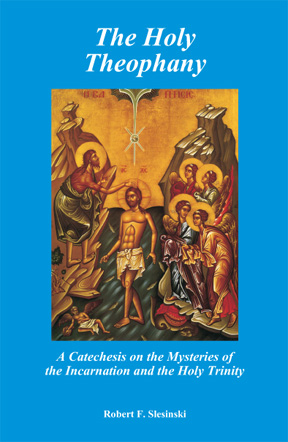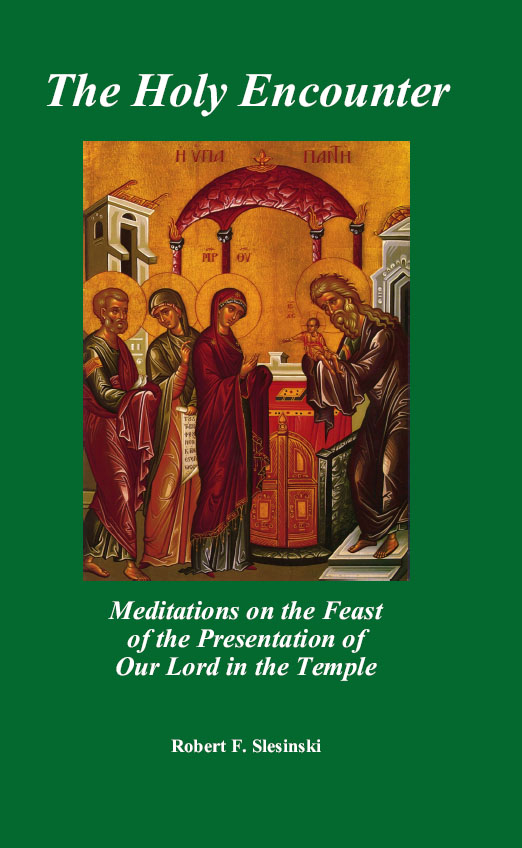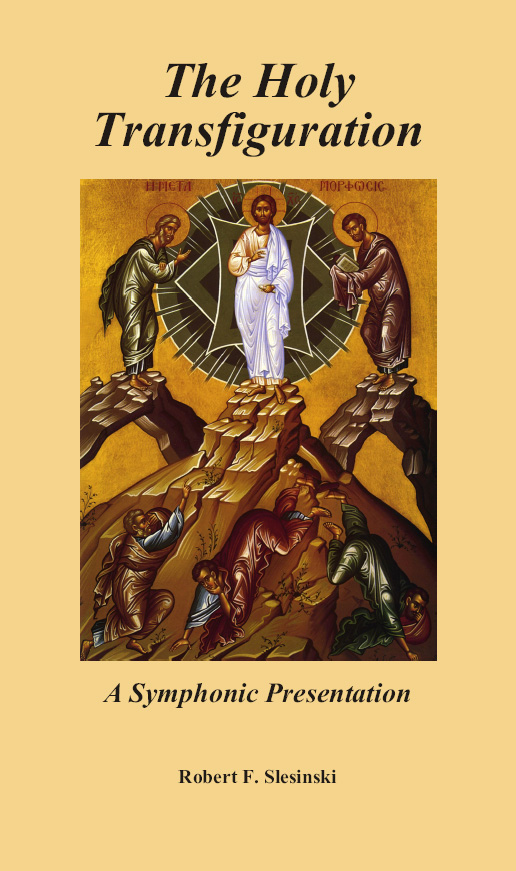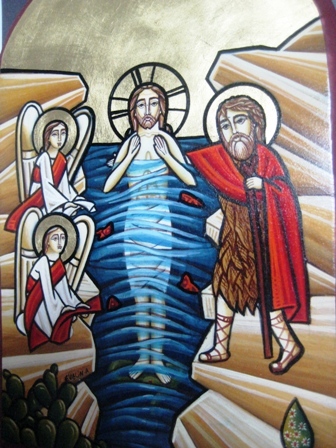If you go here, you will learn a little bit about Nicholas Denysenko's superb book on the Theophany. And if you go here you will wonder, as I just did, "Can it be a full decade now since I interviewed him about this book? Where does the time go?" I cannot answer that question, but I can tell you that there is, even a decade later, still no finer book than his to fete this lovely feast.
mattress,/And you shall sleep restful nights" (St. Ephraim the Syrian).
Thursday, January 6, 2022
On the Lord's Appearing in the Jordan
Wednesday, September 29, 2021
In Praise of Robert Slesinski (II): The Liturgical Feasts
In the first place, if we start at the beginning of the civil calendar, we have The Holy Theophany: A Catechesis on the Mysteries of the Incarnation and the Holy Trinity (ECP, 2011). The publisher's description of this is brief:
This book continues the series of adult education on the feast days of the Byzantine Churches, their theology and liturgical texts. 200 pages with icons.
Next up is the feast that all right-thinking people know closes out the Christmas season: the Encounter/Purification/Candlemas. Fr Robert has turned his hand to this great feast in The Holy Encounter: Meditations on the Feast of the Presentation of the Lord in the Temple (ECP, 2008), 116pp. About this book we are told this:
This book of reflections investigates the feast of the Encounter of Christ with Simeon in the Temple, celebrated on February 2nd, from several theological perspectives.
Finally we come to my favourite feast of the year: The Holy Transfiguration: A Symphonic Presentation (ECP, 2009). 120pp. About this book the publisher tells us this:
The in-depth educational book reflects on the feast of the Transfiguration of Our Lord from a scriptural perspective, comparing the Gospel accounts and writings of Luke, Matthew, Mark, John, Peter and Paul.
Thursday, January 18, 2018
Nicholas Denysenko on Theophany and Chrismation
I also want to call attention to his Chrismation: A Primer for Catholics, published in 2014 by Liturgical Press.
This latter book is the subject of a lecture Nick will be giving here in Ft. Wayne at the University of Saint Francis on 20 February 2018, a Tuesday evening at 7pm in the downtown ballroom in the Business Centre.
In my classes over the last several years with Roman Catholics, especially those who work in parishes as DREs or catechists, I have used Nick's book to help them think through the vexed issue of the age and sequence of the sacraments of initiation, above all of Chrismation/Confirmation.
So come to USF in February to hear Nick lecture. Copies of this and several of his other very recent books will be available for sale and signing by him.
Wednesday, January 6, 2016
The Trinitarian Theophany
About this book the publisher tells us:
This book examines the historical development of the blessing of waters and its theology in the East, with an emphasis on the Byzantine tradition. Exploring how Eastern Christians have sought these waters as a source of healing, purification, and communion with God, Denysenko unpacks their euchology and ritual context. The history and theology of the blessing of waters on Epiphany is informative for contemporary theologians, historians, pastors and students. Offering important insights into how Christians renew Baptism in receiving the blessed waters, this book also proposes new perspectives for theologizing Christian stewardship of ecology in the modern era based on a patristic liturgical synthesis. Denysenko presents an alternative framework for understanding the activity of the Trinity, enabling readers to encounter a vision of how participants encounter God in and after ritual.
Monday, October 15, 2012
Nicholas Denysenko on Theophanic Water Blessings
AD: Tell us a bit about your background.
which I eagerly read. I continued to read Schmemann in my quest to understand liturgy, which I had actively engaged as a choir director. One motivation was my own need to teach liturgical music and to demonstrate to singer how music is a servant of the liturgy; the only way to accomplish this was to learn liturgical structures, history, and theology. My interest in the Theophany water blessing began in a seminar on the Holy Spirit I took with my Doktorvater, Dominic Serra, in 2004. My desire was to unpack the mystery of the so-called "double epiclesis" of the "Great are You" prayer, and my entrance into the project became something much more significant and definitive.
AD: Among several outstanding things about your study I found two especially commendable. First is your ecumenical focus in which you don't just confine yourself to the Byzantine tradition but also examine other Eastern traditions as well as Roman Catholic and Anglican liturgical treatments of Epiphany and blessings. Is there evidence of Eastern traditions influencing the Western, or vice versa?
ND: There is no doubt that the Anglican water blessing draws upon elements of the Byzantine and perhaps Armenian traditions, which are then synthesized in a beautiful blend of Theophany and Western Epiphany themes of "greeting," an anticipation (as it were) of the second coming. In other words, it's as if the Baptism of Jesus at the Jordan has a powerful eschatological flavor in anticipating his revelation as Lord and God at the end of days. More work needs to be done in this area. A Hungarian scholar is about to publish a critical edition of the blessing of waters in Latin which appears to draw heavily upon Greek euchological sources, so there is some evidence of East influencing West, in both medieval and contemporary sources.
AD: You draw on a wonderful array of people in your work, including some very prominent names in Roman Catholic, Byzantine Catholic, Anglican, and Orthodox circles, inter alia. Is it possible today (in the shadow of Baumstark as it were) to do liturgical theology using anything other than such a comparative method?
ND: Employing the comparative method is essential for writing liturgical history, and I humbly consider myself to be an adherent of the Baumstark-Mateos-Taft school of comparative liturgy, with special thanks to Mark Morozowich (Dean of the School of Theology and Religious Studies at The Catholic University of America), who carefully taught me the method. My work is also one of sacramental theology, and here, I employed Monsignor Kevin Irwin's method of Context and Text, an enormously valuable method for gleaning liturgical theology. Liturgical Studies is gradually becoming interdisciplinary, and I think we will see these methods evolve, develop, and grow, especially now, since the liturgical movement and its fruits are increasingly scrutinized and criticized in Catholic and Orthodox circles.
AD: The second thing I greatly cheered was your chapter "Pastoral Considerations." Some liturgical scholars see their task as largely confined to narrating history, which is said to be "instructive but not normative." But you don't confine yourself only to history: you put forward some very interesting practical-pastoral proposals. Tell us what led you to do that.
ND: The task of liturgical history is to inform, and not reform. Two of the best liturgical historians of our time, Taft and Maxwell Johnson, have been quoted accordingly. In the case of the blessing of waters, we are speaking of a living tradition, a real practice in which people participate. In the case of the blessing of waters, history can inform contemporary practice, especially since the Theophany feast occurs right after the New Year, when most people have returned to work (even academics!). This feast is beloved to Eastern Christians: why not maximize and optimize participation? The models I propose are really not attempts to reform, but instead a fine-tuning--pastoral adjustments that are designed to provide people with greater access to the blessings of the feast. My proposals concerning Catholic and Reformed churches draw upon the Roman tradition of adaptation and are offered in the spirit of ecumenical gift-exchange.
AD: The current Ecumenical Patriarch, as I'm sure you're aware, is often called the "green patriarch" for his concern about ecological issues. Do you see the theology of water blessing as connected to current concerns for the environment?
ND: Yes, absolutely. The blessing of waters reveals all of creation as holy, and water, symbolized by the Jordan, is the locus for salvation. All of creation participates in the praise of God as holy, of Christ as Lord, in this feast. Water is God's preferred instrument of salvation, a gift to humanity of restoration to the community of the Trinity. The ecumenical patriarch often referred to the blessing of waters in his many speeches and homilies as a demonstration of Orthodoxy's prioritization of ecological stewardship. I contend in this study that the blessing of waters essentially demands that the Church contribute to the global task of developing a new ethos of water; we have much to contribute from our lived tradition.
AD: Your introduction notes that there is a question, in the Theophany prayers, as to the identity of the one to whom the prayers are addressed. You then note the possibility that perhaps not all prayers are addressed to the Father through Christ, but to Christ directly, and this may pose a challenge to traditional Trinitarian theology from John of Damascus onward and its resolute insistence on "protecting" the "monarchia" of the Father. Say a bit more about this if you would, including some of the ecumenical implications.
AD: Why is it that Theophany ("Jordan") in the East retains, it seems to me (at least among the East-Slavs, with whom I am most familiar), such a place of popularity in the yearly liturgical cycle? Is there something unique about this blessing that people, even without perhaps articulating the whole theology of the feast, grasp in their piety?
ND: Among many people of the Byzantine tradition, the Theophany feast carries a strong popular parallel to Christmas, with carols, and traditional foods, not to mention a similar liturgical structure. There are many potential reasons for the popularity of the Theophany feast, but if I were asked to focus on one, it's the simple human need for water. Somtimes, in a hyperacademic drive to unveil an original theological idea, we overanalyze texts and contexts and overlook the obvious. On Theophany, the people take the blessed water home and use it throughout the year. The churches are packed on similar occasions when food and drink are blessed: on Transfiguration, we bless fruits, and take them home, and of course on Pascha, pastors have to schedule multiple basket blessings. In the moment, we tend to complain about the apparently trite attitude of the people, who don't recognize receiving the Eucharist as the authentic meaning of feast. But it's erroneous to dismiss the people's recognition that the sacred is welcome in their domiciles. Whatever we bring to Church, whether it's water for the Theophany feast, bread and wine for communion, eggs and other savory foods for Pascha baskets, fruit for Transfiguration, or flowers for Dormition, the act of bringing such items to Church is authentic offering and thanksgiving, a recognition that these domestic foods and elements are holy gifts from God freely given to us for our enjoyment. These traditions so dear to the people also serve as stark reminders that the domestic setting, the family (small or extended), is sacred, and that there is no real separation between the holy space of the Church and that of the home. The time has arrived for pastors to recognize these instances as opportunities to build upon what people themselves already recognize, that God is always with us, everywhere we go, and especially in the gifts of creation He has entrusted to our stewardship. These examples represent strong liturgical episodes (to paraphrase Monsignor Kevin Irwin), and not only should we be thankful for them, but we should also recognize the divine philanthropy they convey to us.
ND: I hope the book will be informative for broad audiences. There used to be a saying about Eastern Christianity in North America that it's a well-kept secret. Scholarship on the Eastern Church and her traditions has begun the process of demythologizing Eastern Christianity. Today, almost everyone knows about icons, and among theologians, terms such as hesychasm and theosis are well-known. That said, there are many other Eastern secrets that could be unveiled and have the capacity to tell a more comprehensive narrative story that complements what most people already know about Eastern Christianity. My hope is that this book will provide insights into Eastern Christian liturgical theology that demonstrate its diversity within the tradition, its theological fluidity, and its incredibly beautiful Christology, still experienced in a lived tradition.
ND: I'm writing a book on Chrismation for Western Christians. The premise of my book is that within the Byzantine tradition, Chrismation, like its Western sibling (Confirmation), is also a mystery in search of a theology. My book (under contract with Liturgical Press) endeavors to unpack the liturgical theology of Chrismation in dialogue with the Catholic and Reformed traditions, to take a step towards retrieving the theology of Chrismation. I'm also steadily working on an architecture project profiling select Orthodox parishes in America. My project endeavors to recast the theology of architecture as multifaceted, and no longer an instance of form following function. My thesis contends that contemporary architecture conveys the narrative story of ecclesial communities with the local Church's mission now the primary shaper of architectural form.






